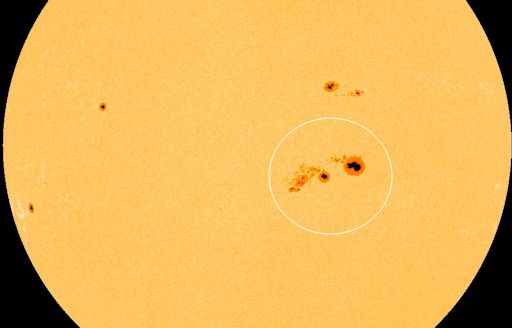STORM WARNING: NOAA forecasters estimate a 90% chance of geomagnetic storms on Jan. 9th when a CME is expected to hit Earth's magnetic field. The speed of the solar wind around Earth could spike to 700 km/s (1.6 million mph) shortly after the impact, sharply compressing Earth's magnetosphere. High-latitude sky watchers should be alert for auroras. Aurora alerts: text, voice.
HUGE SUNSPOT, CHANCE OF FLARES: The source of the incoming CME is AR1944, one of the largest sunspots of the current solar cycle. The active region sprawls across more than 200,000 km of solar terrain and contains dozens of dark cores. The largest could swallow Earth three times over. AR1944 is circled in this Jan. 9th snapshot from NASA's Solar Dynamics Observatory:
As the image shows, the sunspot is almost directly facing Earth. This makes it a threat for geoeffective eruptions. NOAA forecasters estimate an 80% chance of M-class flares and a 50% chance of X-flares on Jan. 9th. Solar flare alerts: text, voice.
Realtime Space Weather Photo Gallery
SPACE WEATHER BALLOON LAUNCHED: Energetic protons are swirling around Earth this week. The ongoing radiation storm was triggered by an X-class solar flare on Jan. 7th, and two days later it is still going strong. To study the effects of the S3-category storm on Earth's atmosphere, yesterday the students of Earth to Sky Calculus launched a space weather balloon from the Sierra Nevada mountains of central California:
Lofted by approximately 200 cubic feet of helium, the balloon ascended to an altitude of approximately 110,000 feet. Its payload contained an x-ray/gamma-ray dosimeter, a GPS altimeter, and a cryogenic thermometer. Together these instruments can form a complete thermal and radiation profile of the atmosphere throughout the flight. Of special interest are aviation altitudes--i.e., between 5 km and 15 km--where planes carry human passengers through the storm. The students want to find out how much ordinary air travelers are exposed during an event like this.
The balloon popped as planned on Jan. 8th and the payload parachuted back to Earth, landing in a remote corner of Death Valley National Park. The students will recover the payload and its data on Jan. 9th. Stay tuned for results. Solar flare alerts: text, voice.
Realtime Space Weather Photo Gallery
VENUS, THE CRESCENT PLANET: Venus is turning its night side toward Earth as it approaches inferior solar conjunction on Jan. 11th. Less than 1% of Venus's sunlit hemisphere is now facing us, which means the planet looks like a razor-thin crescent. If you have a GOTO telescope, command it to slew to Venus. It's visible even in broad daylight:

Shahrin Ahmad of Sri Damansara, Malaysia, took these pictures on Jan. 2nd, 6th and 8th using a 4.5 inch telescope. "It us very interesting to see how fast Venus changes in only 6 days! Today the thinning crescent is only 0.7% illuminated at a distance of 7o from the sun."

Solar wind
speed: 380.1 km/sec
density: 2.8 protons/cm3
explanation | more data
Updated: Today at 1706 UT
X-ray Solar Flares
6-hr max: C1 1342 UT Jan09
24-hr: C1 0216 UT Jan09
explanation | more data
Updated: Today at: 1700 UT
![]()
Daily Sun: 09 Jan 14
Giant sunspot AR1944 has a 'beta-gamma-delta' magnetic field that harbors energy for X-class solar flares. Credit: SDO/HMI
![]()
Sunspot number: 178
What is the sunspot number?
Updated 09 Jan 2014
Spotless Days
Current Stretch: 0 days
2013 total: 0 days (0%)
2012 total: 0 days (0%)
2011 total: 2 days (<1%)
2010 total: 51 days (14%)
2009 total: 260 days (71%)
Since 2004: 821 days
Typical Solar Min: 486 days
Update 09 Jan 2014
The Radio Sun
10.7 cm flux: 195 sfu
explanation | more data
Updated 09 Jan 2014
![]()
Current Auroral Oval:
Switch to: Europe, USA, New Zealand, Antarctica
Credit: NOAA/POES
![]()
Planetary K-index
Now: Kp= 1 quiet
24-hr max: Kp= 3 quiet
explanation | more data
Interplanetary Mag. Field
Btotal: 6.5 nT
Bz: 1.1 nT south
explanation | more data
Updated: Today at 1707 UT
![]()
Coronal Holes: 08 Jan 14
Solar wind flowing from this emerging coronal hole should reach Earth on Jan. 12-13. Credit: SDO/AIA.






